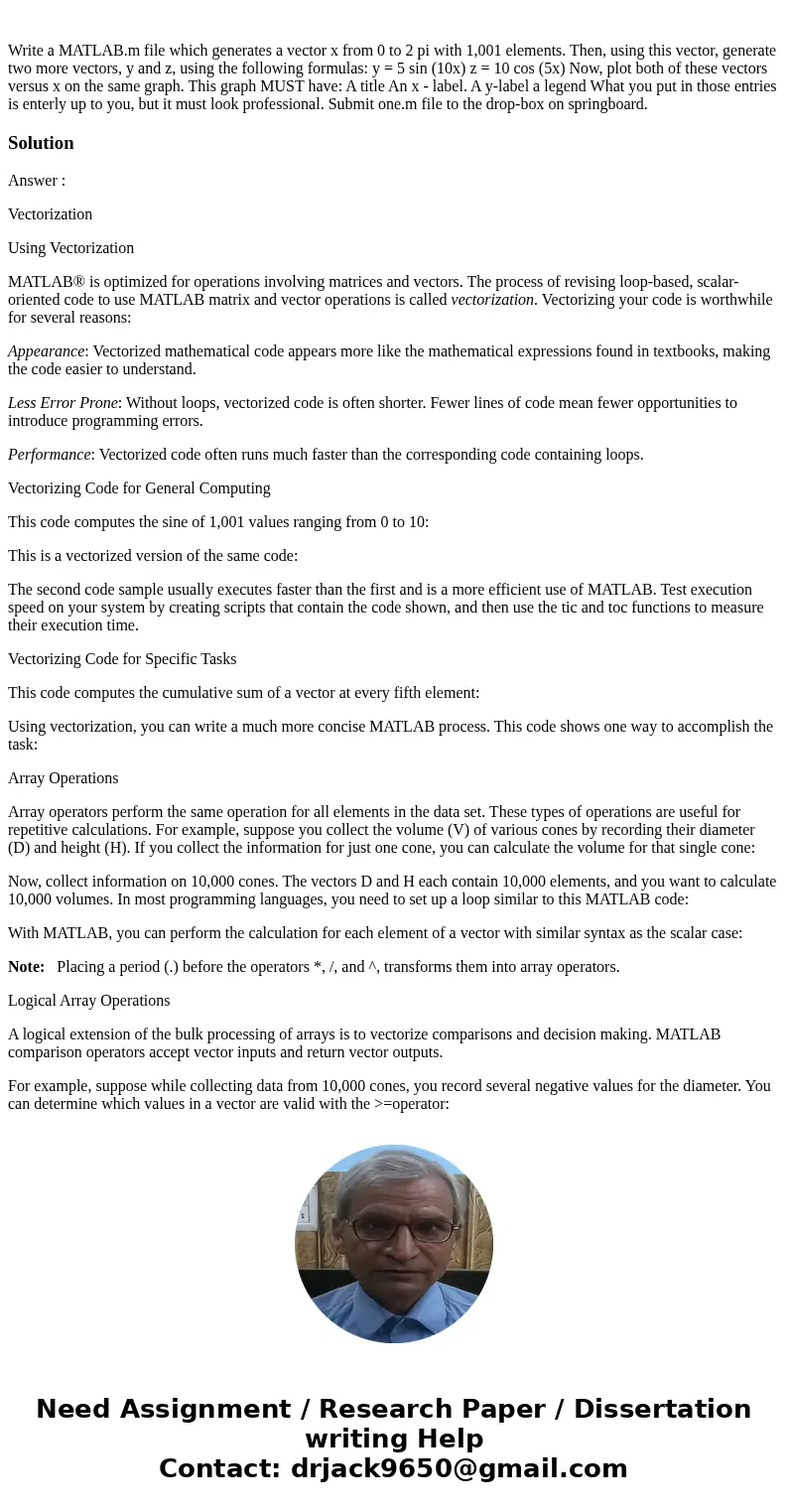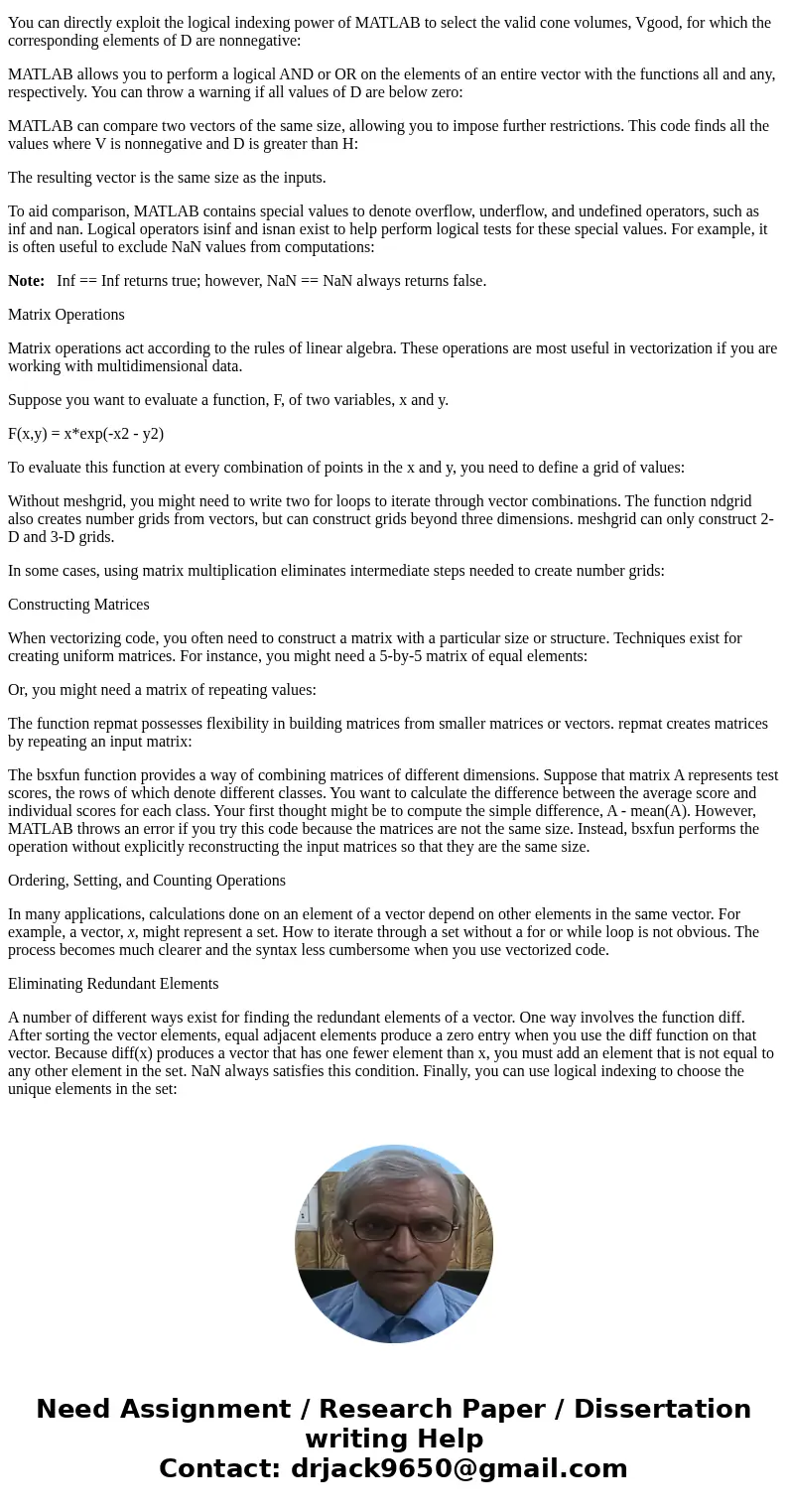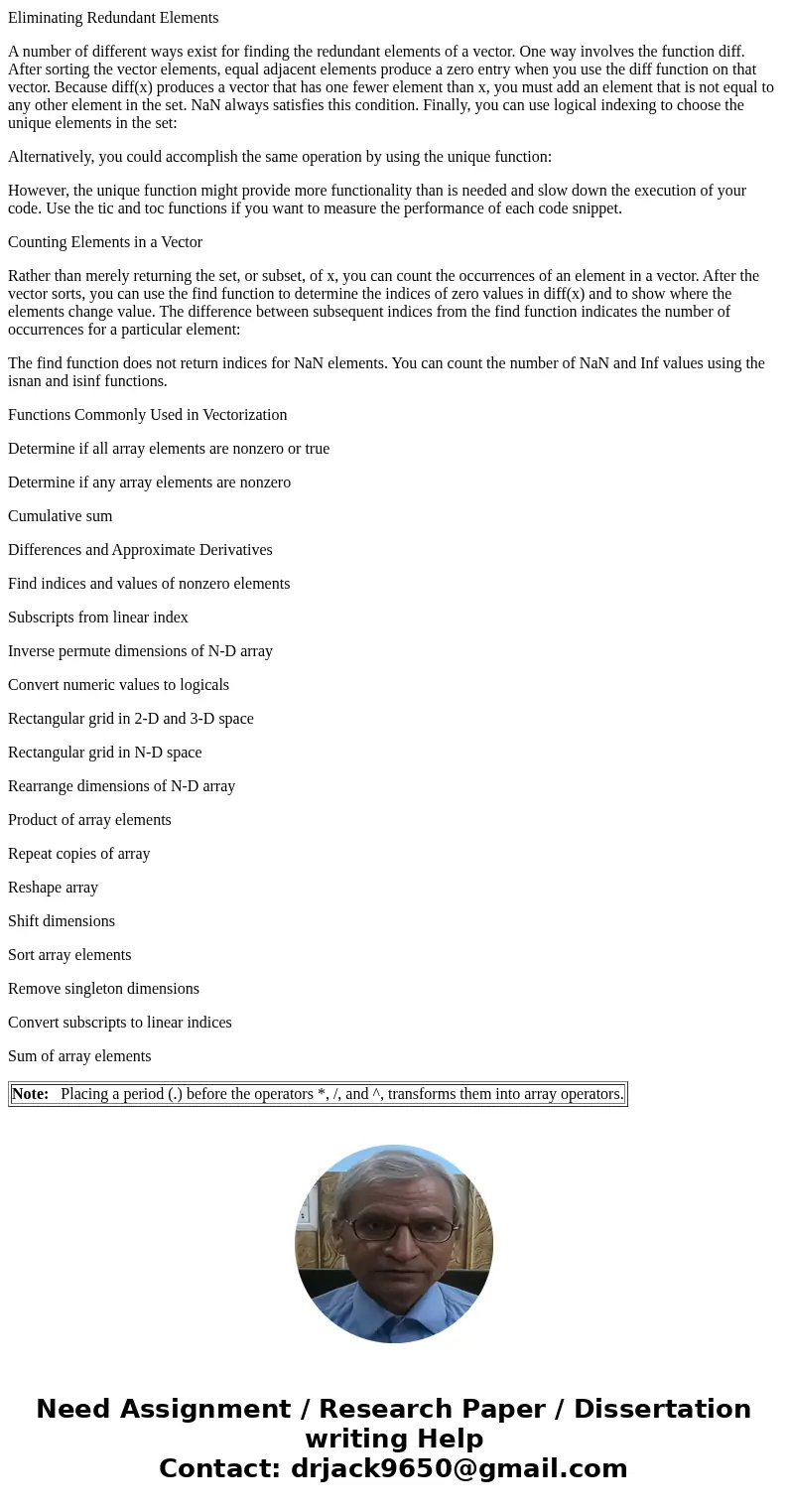Write a MATLABm file which generates a vector x from 0 to 2
Solution
Answer :
Vectorization
Using Vectorization
MATLAB® is optimized for operations involving matrices and vectors. The process of revising loop-based, scalar-oriented code to use MATLAB matrix and vector operations is called vectorization. Vectorizing your code is worthwhile for several reasons:
Appearance: Vectorized mathematical code appears more like the mathematical expressions found in textbooks, making the code easier to understand.
Less Error Prone: Without loops, vectorized code is often shorter. Fewer lines of code mean fewer opportunities to introduce programming errors.
Performance: Vectorized code often runs much faster than the corresponding code containing loops.
Vectorizing Code for General Computing
This code computes the sine of 1,001 values ranging from 0 to 10:
This is a vectorized version of the same code:
The second code sample usually executes faster than the first and is a more efficient use of MATLAB. Test execution speed on your system by creating scripts that contain the code shown, and then use the tic and toc functions to measure their execution time.
Vectorizing Code for Specific Tasks
This code computes the cumulative sum of a vector at every fifth element:
Using vectorization, you can write a much more concise MATLAB process. This code shows one way to accomplish the task:
Array Operations
Array operators perform the same operation for all elements in the data set. These types of operations are useful for repetitive calculations. For example, suppose you collect the volume (V) of various cones by recording their diameter (D) and height (H). If you collect the information for just one cone, you can calculate the volume for that single cone:
Now, collect information on 10,000 cones. The vectors D and H each contain 10,000 elements, and you want to calculate 10,000 volumes. In most programming languages, you need to set up a loop similar to this MATLAB code:
With MATLAB, you can perform the calculation for each element of a vector with similar syntax as the scalar case:
Note: Placing a period (.) before the operators *, /, and ^, transforms them into array operators.
Logical Array Operations
A logical extension of the bulk processing of arrays is to vectorize comparisons and decision making. MATLAB comparison operators accept vector inputs and return vector outputs.
For example, suppose while collecting data from 10,000 cones, you record several negative values for the diameter. You can determine which values in a vector are valid with the >=operator:
You can directly exploit the logical indexing power of MATLAB to select the valid cone volumes, Vgood, for which the corresponding elements of D are nonnegative:
MATLAB allows you to perform a logical AND or OR on the elements of an entire vector with the functions all and any, respectively. You can throw a warning if all values of D are below zero:
MATLAB can compare two vectors of the same size, allowing you to impose further restrictions. This code finds all the values where V is nonnegative and D is greater than H:
The resulting vector is the same size as the inputs.
To aid comparison, MATLAB contains special values to denote overflow, underflow, and undefined operators, such as inf and nan. Logical operators isinf and isnan exist to help perform logical tests for these special values. For example, it is often useful to exclude NaN values from computations:
Note: Inf == Inf returns true; however, NaN == NaN always returns false.
Matrix Operations
Matrix operations act according to the rules of linear algebra. These operations are most useful in vectorization if you are working with multidimensional data.
Suppose you want to evaluate a function, F, of two variables, x and y.
F(x,y) = x*exp(-x2 - y2)
To evaluate this function at every combination of points in the x and y, you need to define a grid of values:
Without meshgrid, you might need to write two for loops to iterate through vector combinations. The function ndgrid also creates number grids from vectors, but can construct grids beyond three dimensions. meshgrid can only construct 2-D and 3-D grids.
In some cases, using matrix multiplication eliminates intermediate steps needed to create number grids:
Constructing Matrices
When vectorizing code, you often need to construct a matrix with a particular size or structure. Techniques exist for creating uniform matrices. For instance, you might need a 5-by-5 matrix of equal elements:
Or, you might need a matrix of repeating values:
The function repmat possesses flexibility in building matrices from smaller matrices or vectors. repmat creates matrices by repeating an input matrix:
The bsxfun function provides a way of combining matrices of different dimensions. Suppose that matrix A represents test scores, the rows of which denote different classes. You want to calculate the difference between the average score and individual scores for each class. Your first thought might be to compute the simple difference, A - mean(A). However, MATLAB throws an error if you try this code because the matrices are not the same size. Instead, bsxfun performs the operation without explicitly reconstructing the input matrices so that they are the same size.
Ordering, Setting, and Counting Operations
In many applications, calculations done on an element of a vector depend on other elements in the same vector. For example, a vector, x, might represent a set. How to iterate through a set without a for or while loop is not obvious. The process becomes much clearer and the syntax less cumbersome when you use vectorized code.
Eliminating Redundant Elements
A number of different ways exist for finding the redundant elements of a vector. One way involves the function diff. After sorting the vector elements, equal adjacent elements produce a zero entry when you use the diff function on that vector. Because diff(x) produces a vector that has one fewer element than x, you must add an element that is not equal to any other element in the set. NaN always satisfies this condition. Finally, you can use logical indexing to choose the unique elements in the set:
Alternatively, you could accomplish the same operation by using the unique function:
However, the unique function might provide more functionality than is needed and slow down the execution of your code. Use the tic and toc functions if you want to measure the performance of each code snippet.
Counting Elements in a Vector
Rather than merely returning the set, or subset, of x, you can count the occurrences of an element in a vector. After the vector sorts, you can use the find function to determine the indices of zero values in diff(x) and to show where the elements change value. The difference between subsequent indices from the find function indicates the number of occurrences for a particular element:
The find function does not return indices for NaN elements. You can count the number of NaN and Inf values using the isnan and isinf functions.
Functions Commonly Used in Vectorization
Determine if all array elements are nonzero or true
Determine if any array elements are nonzero
Cumulative sum
Differences and Approximate Derivatives
Find indices and values of nonzero elements
Subscripts from linear index
Inverse permute dimensions of N-D array
Convert numeric values to logicals
Rectangular grid in 2-D and 3-D space
Rectangular grid in N-D space
Rearrange dimensions of N-D array
Product of array elements
Repeat copies of array
Reshape array
Shift dimensions
Sort array elements
Remove singleton dimensions
Convert subscripts to linear indices
Sum of array elements
| Note: Placing a period (.) before the operators *, /, and ^, transforms them into array operators. |



 Homework Sourse
Homework Sourse